The diaphragm is a long muscle that lies below the lungs and helps the expansion and contraction of the lungs during respiration. Diaphragm paralysis can be caused by different pathological mechanisms involving the lungs and the phrenic nerve, which innerves the diaphragm and is attached to the cervical spine. In TCM, diaphragm paralysis is given a different diagnosis, established after an exhaustive interrogation of the symptoms and history of each patient. In addition, acupuncture for diaphragm paralysis aims to improve patients’ respiration.
What Causes Diaphragm Paralysis?
Let’s look at the anatomy of the diaphragm. It has several passages like the foramen of Morgagni and Larrey, the vena Cava hiatus, the esophageal hiatus, the aortic hiatus, etc. In those passages, many arteries, veins, nerves, and the esophagus pass through, making the diaphragm a vital organ that directly influences breathing, digestion, blood circulation, nervous function, etc.
There are different conditions involved in the weakening and paralysis of the diaphragm. In Western medicine, the most recurrent diagnosis are congenital central hypoventilation syndrome, nervous system diseases, chronic obstructive pulmonary disease, spinal cord injury, arthritis in the cervical spine, cancer, and the like. The most significant cause of diaphragm paralysis, however, is damage to the phrenic nerve, which connects to the nerve roots of your spinal cord between C3 and C5. When the phrenic nerve is damaged, it sends weak signals to the diaphragm to contract and relax.
Gé is how the diaphragm is called Chinese medicine. It is a muscle deeply related to life force and vitality because all the primary meridians cross through the diaphragm. It regulates the ascending and descending movement, Blood, qi, and fluids between the upper and lower parts of the body. The excellent function of Gé in TCM is related to the Liver, which is the organ responsible for nourishing the muscles with Blood, the Spleen and the Kidneys. Most acupressure points for breathing difficulties are connected to the diaphragm in one way or another.
Does Acupuncture Help A Paralyzed Diaphragm?

To date, there aren’t enough scientific studies specifically pointing out the efficiency of acupuncture for diaphragm paralysis. However, studies on the effects of acupuncture in cases of diaphragm dysfunction due to chronic obstructive pulmonary disease show very positive results. A systematic review of different scientific studies and clinical trials reported that acupuncture improved diaphragm strength in two studies, besides effectively enhancing diaphragmatic motor performance.
In yet another clinical study on healthy volunteers that underwent acupuncture treatment, the results showed that acupuncture significantly improved diaphragm function in the volunteers, improving the inspiratory thickening fraction during respiration at vital capacity. These results are optimistic in the context of acupuncture for diaphragm paralysis because the use of acupuncture for neuropathy has been shown in other studies to be efficient. So if paralysis happens due to damage in the phrenic nerve, there’s a big chance that acupuncture can help.
What Are The Acupressure Points For Diaphragm Paralysis?
Acupoint: ST-36 (Other Names: Stomach-36/Zu San Li/Leg Three Miles)
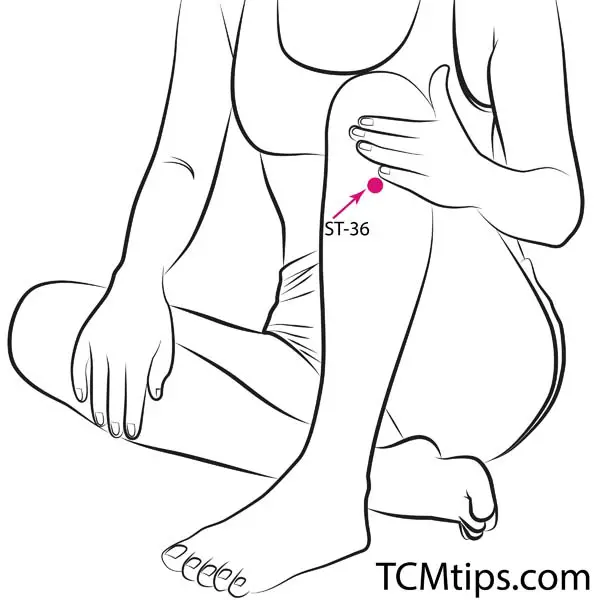
This acupoint is located below the kneecaps, about 1cm from the tibia’s anterior crest.
You can massage this acupoint as deep as possible, as long as it’s not too painful. Either press or massage this point for about fifteen minutes daily.
Acupoint: Ren-2 (Other Names: The Conception Vessel-2/Qu gu/Crooked Bone)
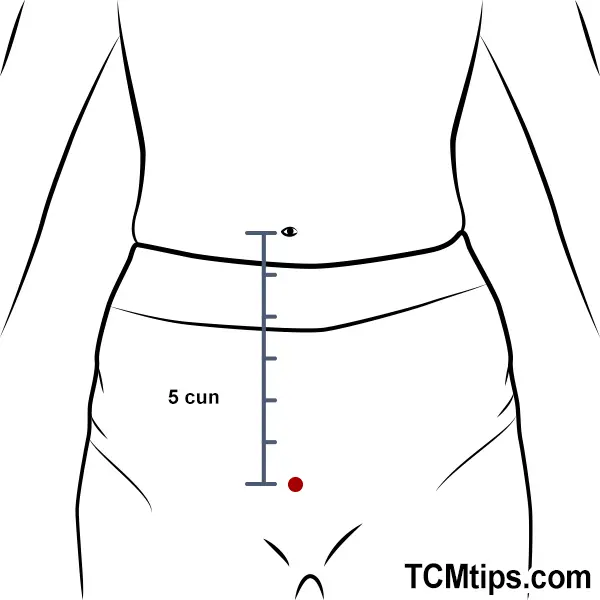
You will find Ren-2 on the lower abdomen at the midline, at the border superior to the pubic symphysis
Ren-2 is traditionally used for problems in genitourinary organs. The Ren meridian is a channel that acts as a reservoir of qi. It runs in the midline of the anterior side of the body all the way from the anus up to the chin. The Ren Mai meridian points are strategic in treating the diaphragm due to its course and upward flow.
Be careful while stimulating this acupoint. You don’t need to apply firm pressure, instead, feel the texture of your skin and muscle and try to gradually deepen the pressure without hurting yourself. Do this for about four minutes.
Acupoint: Ren-4 (Other Names: The Conception Vessel-4/Guan Yuan/Origin Pass)
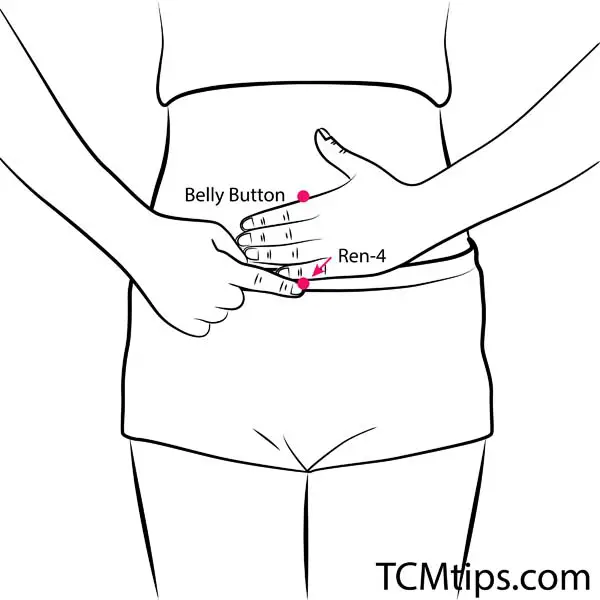
You can find this point at four fingers’ breadth below your belly button on the midline of your lower abdomen.
Ren-4 is an essential point from the Ren Mai meridian. It is a getaway to the yuan qi, the source of nourishment for the entire body. It’s one of the most potent acupoints to strengthen the body and mind. This acupoint significantly affects the yin and yang of the Kidneys, which are the sustaining energies for the body. For this reason, Ren-4 is considered an essential acupoint in the treatment with acupuncture for diaphragm paralysis. In addition, ren-4 is utilized in acupuncture for a brain tumors.
Be careful while stimulating this point. You don’t need to apply firm pressure, instead, feel the texture of your skin and muscle and try to gradually deepen the pressure without hurting yourself. Do this for about four minutes.
Acupoint: Ren-6 (Other Names: The Conception Vessel-6/Qi Hai/Sea of Qi)
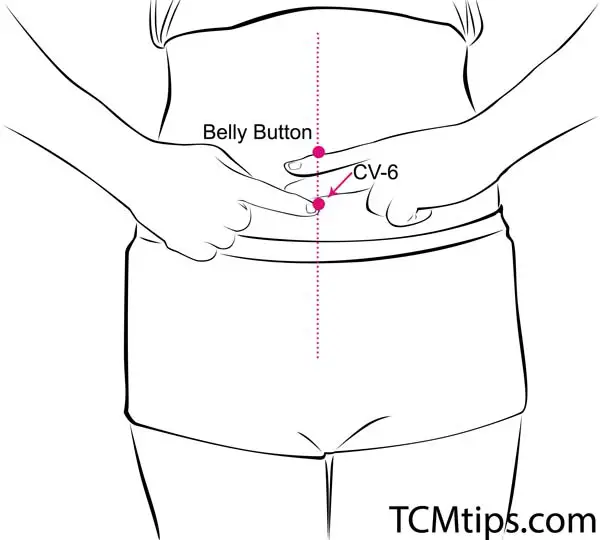
Ren-6 is located 1.5 cun below the navel, and 3.5 cun above the pubic symphysis on the midline of the abdomen.
Ren-6 is the center of energy for the whole body. Together with Ren-4, it’s known as Dantian, the “Cinnabar Field”. Applying heat to this point is recommended for people who feel weak and low on energy. Ren-6 enhances the source of yang of the body in the Kidneys, improving metabolism, digestion, and cognition. Since the yin and yang are inseparably interconnected, this acupoint’s stimulation also indirectly enriches the yin. Ren-6 is utilized in acupuncture for wrist tendonitis.
You can either massage or apply a warm water bottle on this point, leaving it the until you feel revigorated.
Acupoint: SP-15 (Other Names: Spleen-15/Da Heng/Great Horizontal)
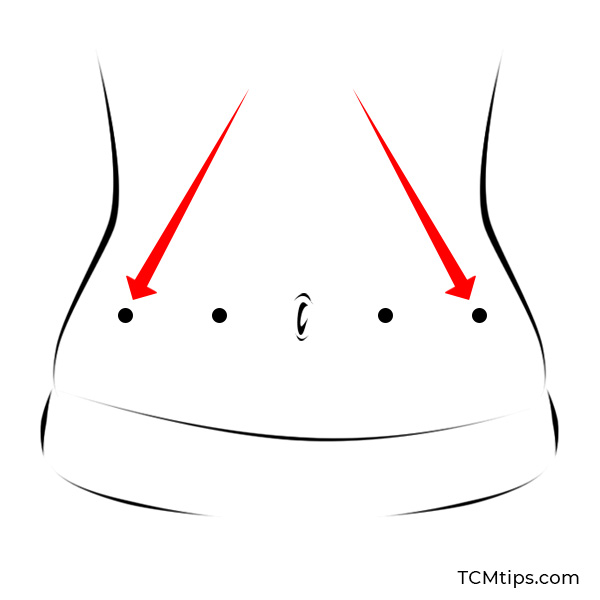
This point is located on the midclavicular line, 4 cun lateral to the center of the belly button.
SP-15 belongs to the Spleen channel. In Chinese medicine, the Spleen is connected to the Lungs in the Five Phases theory. Points of the Spleen channel are often utilized to improve the function of the lungs and resolve breathing problems. This acupoint is traditionally utilized for abdominal complaints, such as chronic constipation, besides having analgesic properties. It’s located close to the diaphragm and utilized to regulate the Qi. SP-15 is one of the best acupressure points for constipation as well.
Gently press on this point for a couple of seconds, releasing it intermittently with the pressure. You can do this for about five minutes.
Acupoint: Bl-13 (Other Names: Urinary Bladder-13/Fei Shu/Lung Transporter)
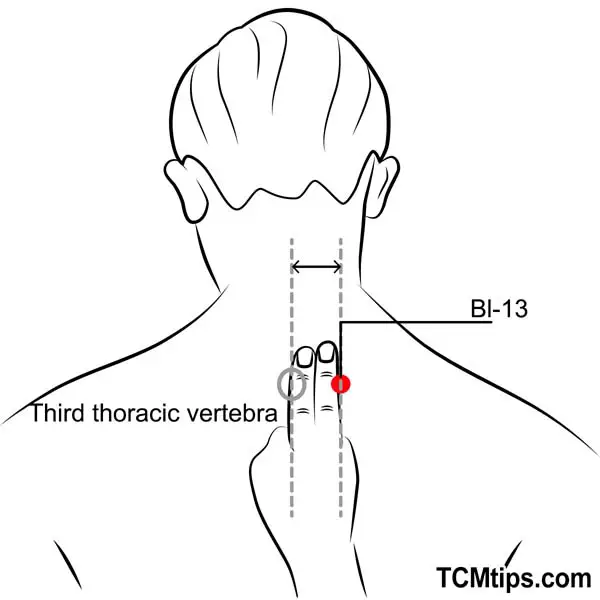
This acupoint is located on the back, on both sides of the lower corner of the spinous process of the 3rd thoracic vertebra.
Bl-13 is the Back-shu point of the Lung. This acupoint has very important effects on the lungs and is traditionally used in chronic cases and severe diseases of the lungs. It’s one of the main acupressure points for COPD. Scientific studies have shown that this acupoint, combined with other acupuncture points, can ameliorate dyspnea on exertion and improve the respiratory frequency and lung ventilatory capacity. Bl-13 is also utilized in acupuncture for alopecia areata.
Apply firm pressure at this point, release, and repeat this procedure for about four minutes.
Acupoint: Bl-23 (Other Names: Urinary Bladder-23/Shen Shu/Kidney Transporter)
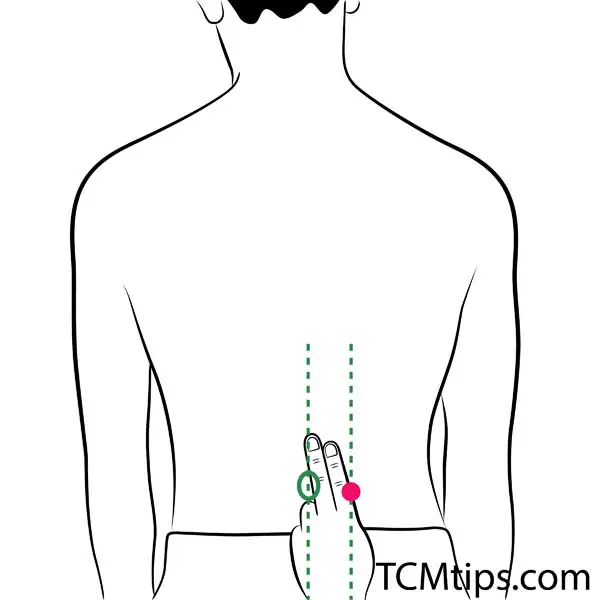
You can find this point 1.5 cun to the side to the lower border of the spinous process of the 2nd lumbar vertebrae.
This point is a command point to strengthen the Kidneys, which are the source of yin and yang in the body. Acupuncture on this acupoint has many beneficial effects on the body and the mind too. Since the Kidneys are connected to determination and initiative, this acupoint helps to develop these psychological attributes. It’s been shown that acupuncture at Bl-23 suppresses bone resorption, preventing bone loss. In addition, Bl-23 is also one of the acupressure points for eye-floaters.
Apply firm pressure at this point, release, and repeat this procedure for about four minutes.
Takeaways
Acupuncture for diaphragm paralysis involves acupuncture points that affect the diaphragm, the phrenic nerve, the lungs, and other systems in the brain, such as the orexin system. Acupressure is a side-effect-free therapy that can be done at home as an alternative to acupuncture. You can carry your therapy either as a stand-alone or adjunct treatment along with other therapies that you might be doing. Always consult your doctor if you don’t have a diagnosis for your symptoms.
- ST-36 is a traditional acupoint to treat the Stomach, affecting the hypothalamus and the medulla, affecting the orexin system.
- Ren-2 belongs to the Ren Mai meridian and treats the genitourinary organs, which cross the diaphragm in its upward flow.
- Ren-4 is one of the most potent acupoints to strengthen the body and mind by stimulating the source of the yuan qi.
- Ren-6 is the center of energy for the whole body. Together with Ren-4, known as Dantian, the “Cinnabar Field”, it’s recommended for people who feel weak and have little energy.
- SP-15 belongs to the Spleen channel and helps improve the function of the Lungs and resolve breathing problems.
- Bl-13 can ameliorate dyspnea on exertion and improve the respiratory frequency and lung ventilatory capacity. It’s also one of the acupressure points for breathing difficulties.
- Bl-23 is a command point to strengthen and nourish the Kidneys, which are the source of yin and yang in the body.

Try our Anti-Aging Gua Sha Tool designed to bring out your skin’s natural glow.
Best Gua Sha Product- Anti-Aging: The tool is designed to target 11 specific aging signs such as wrinkles and sagging skin. By following the 7-step routine, users can improve skin firmness and reduce fine lines naturally.
- Enhances Skincare Routine: It works effectively with serums and lotions, boosting absorption and efficacy of skincare products.
- Visible Skin Improvement: Users can expect a smoother complexion, reduced puffiness, and a more youthful appearance.
 P. Sze
P. Sze 

















